Apple A1954 Tablet Device User Manual iPad User Guide
Apple Inc. Tablet Device iPad User Guide
Apple >
Contents
Users Manual 4

Summon Siri with the Home button. Press and hold the Home button, release the
button, then make your request. Or, instead of waiting for Siri to notice that youʼve
stopped talking, continue to hold down the Home button while you speak, then release it
when you finish.
If youʼre using a headset, you can use the center or call button in place of the Home
button. If youʼre using AirPods, double-tap an AirPod until Siri appears.
Find out what Siri can do. Ask Siri “What can you do?” or tap .
Make corrections. If Siri misunderstands you:
Clarify your request: Tap , then rephrase your request.
Edit your request with text: Above the response from Siri, tap “Tap to Edit,” then use
the onscreen keyboard.
Change a message before sending it: Say “Change it.”
Ask Siri to translate. (beta) Siri can translate a phrase from English to Chinese, Spanish,
French, German, or Italian. Ask Siri “How do you say” followed by the phrase and
language to which you want to translate. Siri speaks the translation out loud, which can
help you with pronunciation.
Change the voice for Siri. (not available in all languages) Go to Settings > Siri &
Search > Siri Voice. Choose a male or female voice for Siri or even change the accent.
Adjust the volume for Siri. Use the volume buttons while youʼre interacting with Siri. For
voice feedback options, go to Settings > Siri & Search > Voice Feedback.
Prevent access to Siri when iPad is locked. Go to Settings > Siri & Search > Allow Siri
When Locked.
Prevent Siri from responding when you donʼt want it to. Place your device face down.

Tell Siri about yourself
If you tell Siri about yourself—including things like your home and work addresses, and
your relationships—you can get personalized service so you can say things like, “Send a
message to my husband.”
Tell Siri who you are. Fill out your info card in Contacts, then go to Settings > Siri &
Search > My Information and tap your name.
Tell Siri how to say your name. Say something like “Learn to pronounce my name.”
Tell Siri about a relationship. Say something like “Eliza Block is my wife” or “Ashley
Kamin is my mom.”
Keep what Siri knows about you up to date on your Apple devices. Go to Settings,
then sign in to iCloud with the same on all your devices. Everything about you is
encrypted, so your personal information remains private.
Note: Siri uses Location Services when your requests require knowing your location. See
.
Proactive intelligence
Siri learns from you, and can sometimes anticipate what you want and make suggestions
before you make a request or ask a question. Your personal information—which is
encrypted and remains private—stays up to date across all your devices where youʼre
signed in to iCloud using the same Apple ID. As Siri learns about you on one device, your
experience with Siri is improved on your other devices.
Based on how you use your iPad, Siri makes suggestions for what you might want to do
next. Siri might help when you:
Create email and events: When you start adding people to an email or calendar event,
Siri suggests the people you included in previous emails or events.
Leave for an event: If your calendar event includes a location, Siri assesses traffic
conditions and notifies you when to leave.
Type: As you enter text, Siri can suggest names of movies, places—anything you
viewed recently. If you tell a friend youʼre on your way, Siri can even suggest your
estimated arrival time.
Search in Safari: (iPad Air 2 and later) Siri makes suggestions based on what you were
just reading.
Apple ID
Location Services

Confirm an appointment or a book flight on a travel website: (iPad Air 2 and later) Siri
asks if you want to add it to your calendar.
Read News stories: As Siri learns which topics youʼre interested in, theyʼll be
suggested in News.
Siri and apps
Siri works with many of the apps on iPad, including FaceTime, Messages, Maps, Clock,
Calendar, and Music. For example, you can say things like:
“FaceTime Mom”
“Do I have any new texts from Rico?”
“Set an alarm for 8 a.m.”
To get personalized service for requests like “FaceTime Mom,” tell Siri about yourself and
your relationships. See .
More examples of how you can use Siri with apps appear throughout this guide.
Use Siri as your personal DJ. Apple Music knows your tastes. So when you tell Siri to
play some music, youʼll hear a song you love. Siri can also answer music trivia questions
like “Whoʼs the drummer in this song?” See .
Listen to the latest news. (not available in all regions) Say something like, “Hey Siri, play
some news.” You can also ask for business, sports, or music news.
Use Siri with third-party apps. Some apps from the App Store also support Siri. These
include apps that let you book a ride, send a message, search photos, place calls, and
track your workouts. Look for apps that support Siri in the App Store.
Turn off Search & Siri suggestions. Go to Settings > Siri & Search, then turn off Search
& Siri suggestions for specific apps.
Tell Siri about yourself
Start Apple Music trial
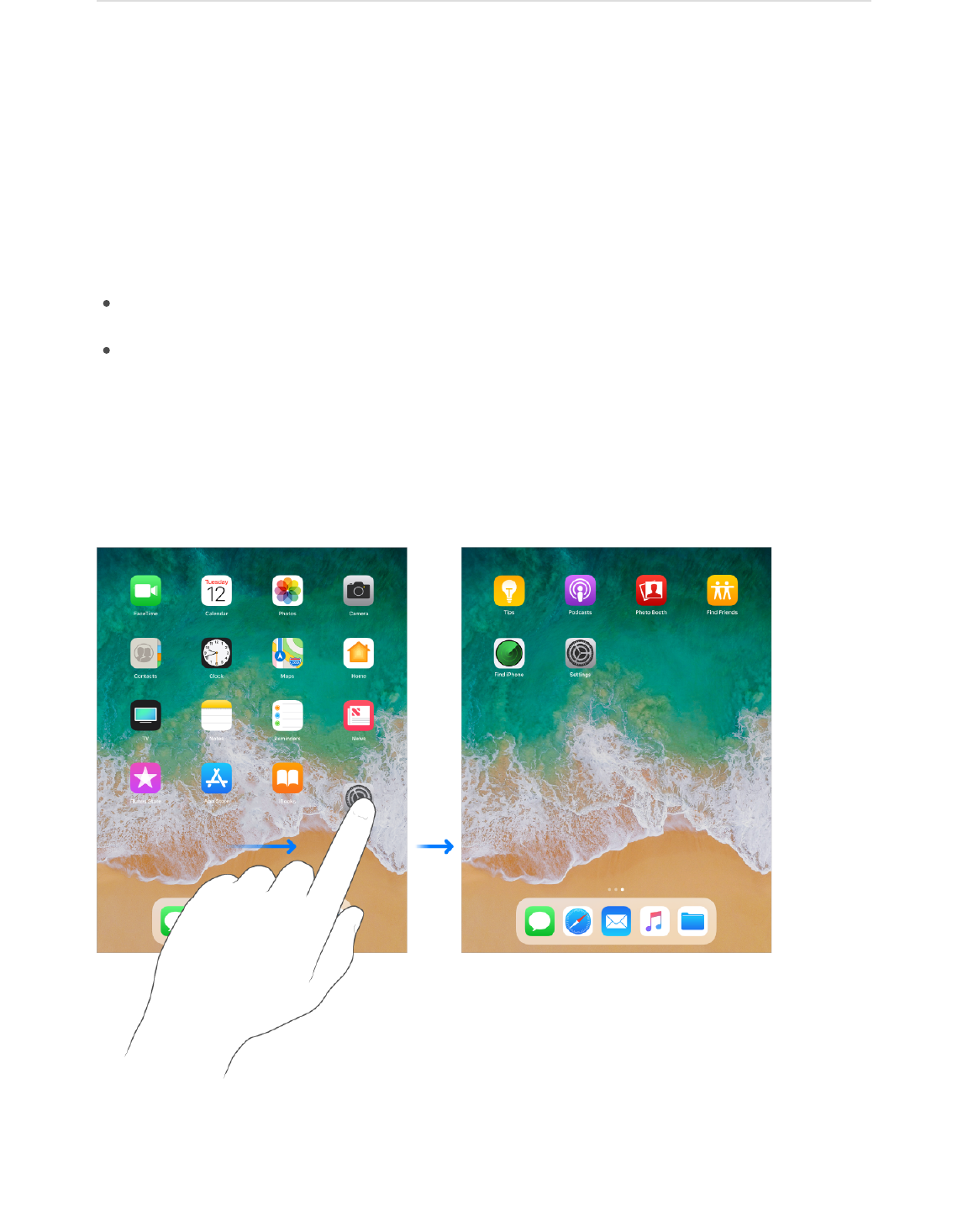
Arrange your apps
Rearrange the Home screen and customize the Dock. Touch and hold any app on the
Home screen, then drag it to where you want it (wait until the apps rearrange to lift your
finger).
Move the app to a different Home screen: Drag it to the edge of the screen.
Move the app to the Dock: Drag it to the left side of the Dock at the bottom of the
screen.
You can also touch and hold an app until the app icons jiggle, drag the app to where you
want it, then press the Home button to save your arrangement. To select multiple apps to
move at once, touch and hold an app until the app icons jiggle, drag the app slightly, then
tap additional apps with another finger.
Create an additional page for the Home screen. While arranging apps, drag an app to
the right edge of the last page. The dots above the Dock show how many pages you have
and which one youʼre viewing.
Personalize your iPad

Start over. Go to Settings > General > Reset, then tap Reset Home Screen Layout to
return the Home screen and apps to their original layout. Any folders youʼve created are
removed, and apps youʼve downloaded are placed after apps that came with your iPad.
Remove apps
Remove apps from the Home screen. Touch and hold an app on the Home screen until
the app icons jiggle, then tap on the apps you want to remove. When you finish, press
the Home button.
In addition to removing third-party apps, you can remove some built-in Apple apps that
come with your iPad:
(Contact information remains available through Messages, Mail, FaceTime,
and other apps. To remove a contact, you must restore Contacts.)
Calendar
Contacts
FaceTime
Files
Find My Friends
Home
iBooks
iTunes Store
Mail
Maps
Music
News
Notes
Photo Booth
Podcasts
Reminders
Tips
TV
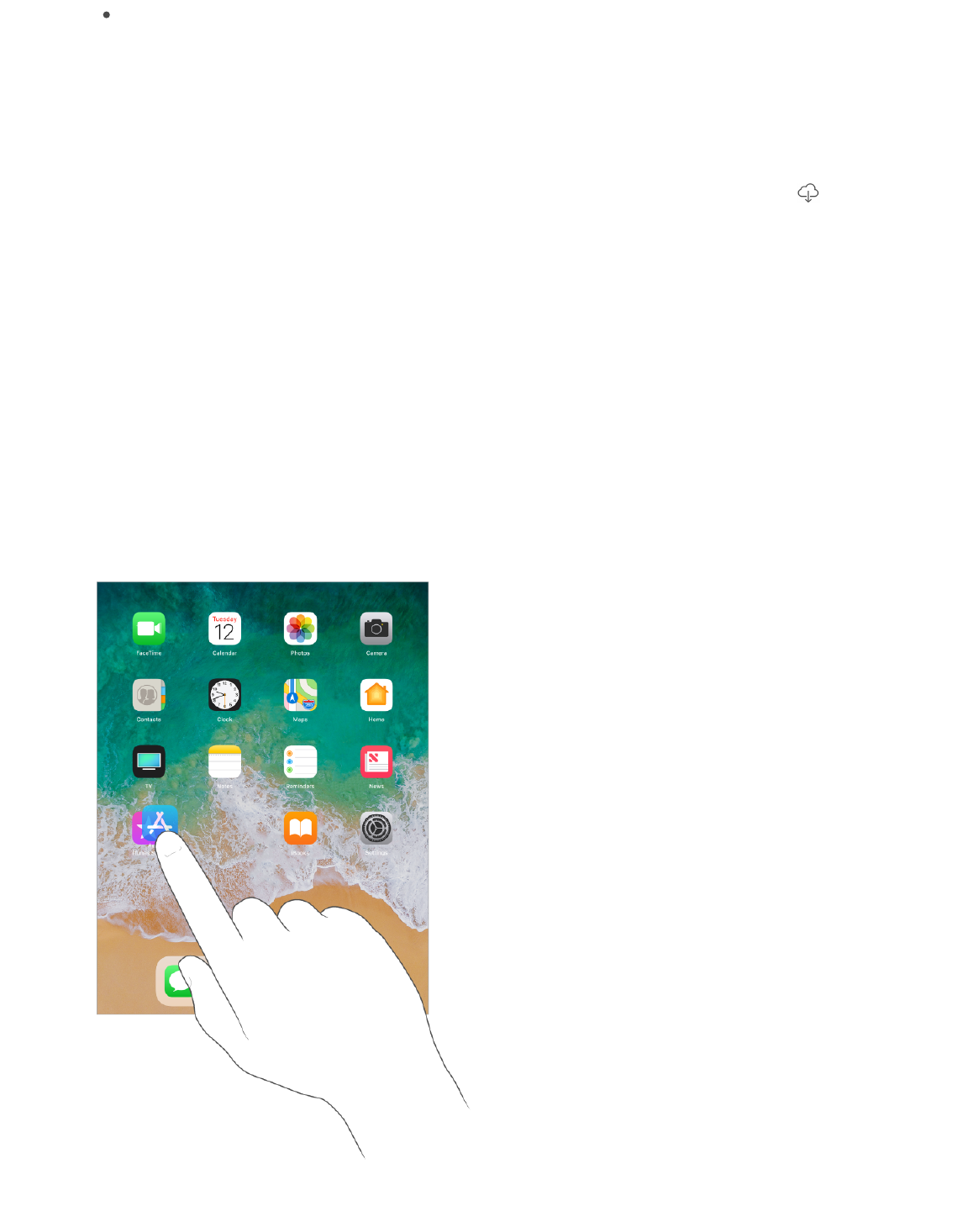
Note: When you remove a built-in app from your Home screen, you also remove any
related user data and configuration files. Removing built-in apps from your Home screen
can affect other system functionality. For more information, see the Apple Support article
.
Restore an app you removed. Go to the App Store, search for the app, then tap .
Organize with folders
Create a folder. Touch and hold an app on the Home screen, drag it onto another app
you want in the same folder, then lift your finger. Tap the name of the folder to rename it.
Drag apps into or out of the folder.
To quickly create a folder with multiple apps, touch and hold an app until the app icons
jiggle, drag the app slightly, then tap additional apps with another finger. While holding
the selected apps with one finger, use another finger to press the Home to stop the icons
from jiggling. Drag your selection onto another app you want in the same folder, then lift
your finger.
You can have multiple pages of apps in a folder.
Videos
Remove built-in Apple apps from the Home screen
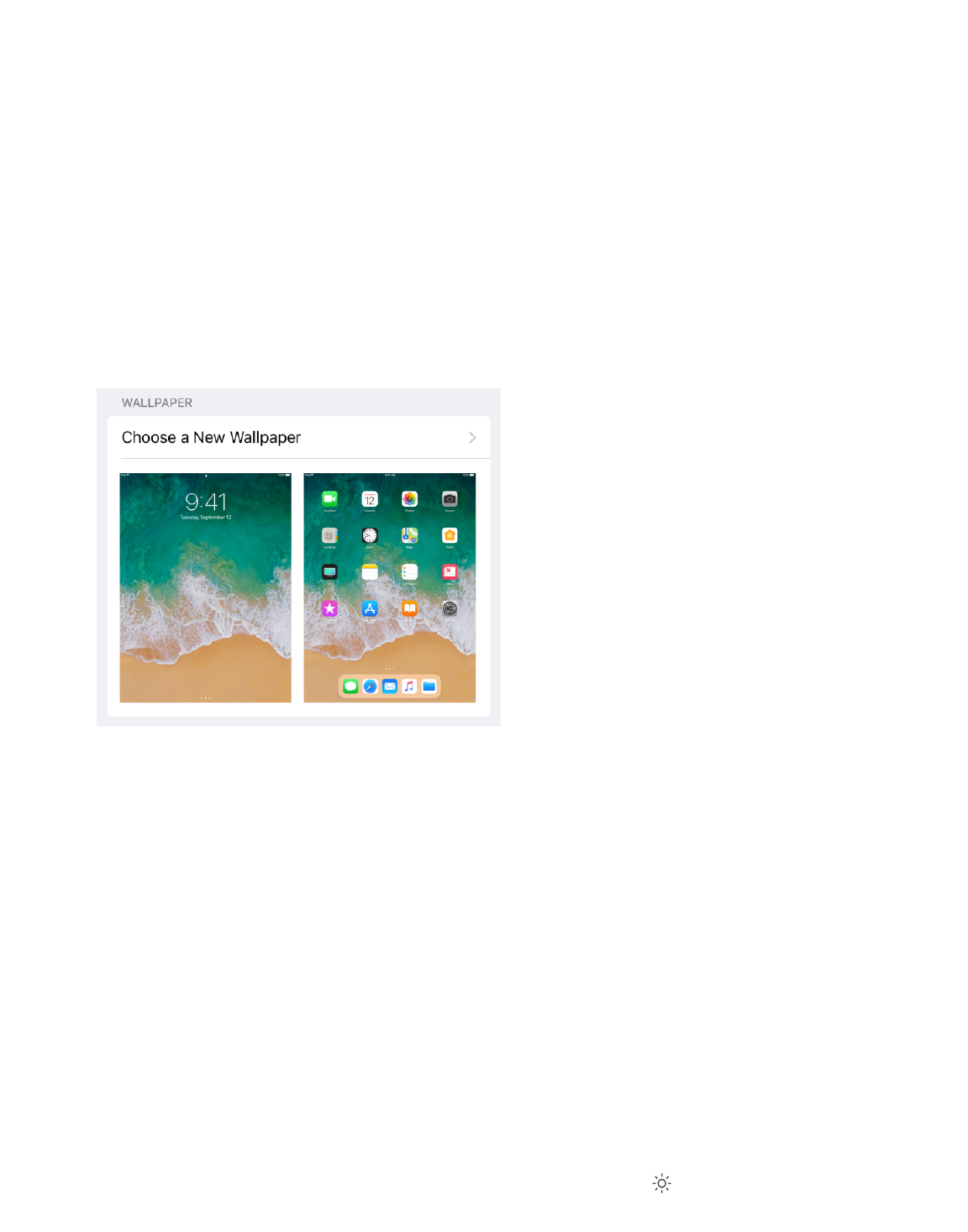
Delete a folder. Tap a folder, then drag out all the apps—the folder is deleted
automatically.
Change the wallpaper
Wallpaper settings let you set an image or photo as wallpaper for the Lock screen or
Home screen. You can choose from dynamic and still images.
Change the wallpaper. Go to Settings > Wallpaper > Choose a New Wallpaper.
Tip: If you choose your own image as wallpaper, you can pinch open to zoom in on
your selected image, then drag your finger to move the image. Pinch closed to zoom
back out.
When choosing an image for new wallpaper, you may be able to tap Perspective Zoom to
make your wallpaper move when you change the angle you view the screen. To turn on
the Perspective Zoom option for wallpaper youʼve already set, go to Settings > Wallpaper,
then tap the image of the Lock screen or Home screen.
Note: Perspective Zoom doesnʼt work if Reduce Motion (in Accessibility settings) is
turned on. See .
Adjust the screen brightness and color balance
Dim the screen to extend battery life. Use Night Shift to shift the colors in your display to
the warmer end of the spectrum at night and make viewing the screen easier on your
eyes. On supported models, use True Tone to automatically adapt the color and intensity
of the display to match the light in your environment.
Adjust the screen brightness. Open Control Center, then drag . Or go to Settings >
Display & Brightness, then drag the slider.
Reduce motion

Automatically adjust the screen brightness. Go to Settings > General > Accessibility >
Display Accommodations, then turn on Auto-Brightness. iPad adjusts the screen
brightness for current light conditions using the built-in ambient light sensor.
Use True Tone. (On supported models) Open Control Center, touch and hold , then tap
to turn True Tone off or on. Or go to Settings > Display & Brightness, then turn on True
Tone.
Turn Night Shift on or off. Open Control Center, touch and hold , then tap . Or go to
Settings > Display & Brightness > Night Shift.
Turn on Night Shift manually—helpful when youʼre in a darkened room during the day, for
example—or go to Settings > Display & Brightness > Night Shift to schedule it to turn on
automatically. If you schedule Night Shift to turn on from sunset to sunrise, iPad uses the
data from your clock and your geolocation to determine when itʼs nighttime for you.
Note: You wonʼt see the option to turn on Night Shift from sunset to sunrise if youʼve
turned off Location Services in Settings > Privacy, or if youʼve turned off Setting Time
Zone in Settings > Privacy > Location Services > System Services.
To adjust the color balance for Night Shift, go to Settings > Display & Brightness > Night
Shift, then drag the slider toward the warmer or cooler end of the spectrum.
Magnify the screen with Display Zoom
With iPad Pro (12.9-inch), you can magnify the screen display. Go to Settings > Display &
Brightness. Tap View (below Display Zoom), choose Zoomed, then tap Set. For additional
zoom features, see .
App extensions
Some apps let you extend the functionality of your apps on iPad. An app extension may
appear as a sharing option, an action option, a widget in Today View, a file provider, or a
custom keyboard. For example, if you download Pinterest to iPad, Pinterest becomes
another option for sharing when you click .
App extensions can also help you edit a photo or video in your Photos app. For example,
you can download a photo-related app that lets you apply filters to photos.
Install app extensions. Download the app from the App Store, open the app, then follow
the onscreen instructions.
Turn sharing or action options on or off. Tap , then tap More (drag options to the left
if necessary). Turn off third-party sharing or action options (theyʼre on by default).
Zoom

Organize sharing and action options. Tap , then tap More (drag options to the left if
necessary). Touch and drag to rearrange your options.
For more information about Today widgets, see . For more information about
Sharing options, see .
Your iPad name
The name of your iPad is used by iTunes and iCloud.
Change the name of your iPad. Go to Settings > General > About > Name.
Set restrictions
You can set restrictions for some apps, and for purchased content. For example, parents
can restrict explicit music from appearing in playlists, or disallow changes to certain
settings. Use restrictions to prevent the use of certain apps, the installation of new apps,
or changes to accounts or the volume limit.
Turn on restrictions. Go to Settings > General > Restrictions, then tap Enable
Restrictions. Youʼll be asked to define a restrictions passcode thatʼs necessary to change
the settings you make. This can be different from the passcode for unlocking iPad.
Important: If you forget your restrictions passcode, you must restore the iPad software.
See .
Today View
Share from apps
Restore iPad

International keyboards
Use international keyboards
With international keyboards you can type text in many different languages, including
Asian languages and languages written from right to left. For a list of supported
keyboards, go to Appleʼs , choose your iPad, click Tech Specs, then scroll to
Languages.
Manage keyboards. Go to Settings > General > Keyboard > Keyboards.
Add a keyboard: Tap Add New Keyboard, then choose a keyboard from the list.
Repeat to add more keyboards.
Remove a keyboard: Tap Edit, tap next to the keyboard you want to remove, tap
Delete, then tap Done.
Edit your keyboard list: Tap Edit, drag next to a keyboard to a new place in the list,
then tap Done.
If youʼve added keyboards in other languages, you can type in two languages without
having to switch between keyboards. Your keyboard automatically switches between the
two languages you type in most often. (Not available for all languages.)
Switch keyboards. Touch and hold , then slide your finger to the name of the
keyboard.
You can also tap to switch from one keyboard to the other. Continue tapping to access
other enabled keyboards.
Enter accented letters or other characters. Touch and hold the related letter, number,
or symbol, then slide to choose a variant. For example:
On a Thai keyboard: Choose native numbers by touching and holding the related
Arabic number.
On a Chinese, Japanese, or Arabic keyboard: Suggested characters or candidates
appear at the top of the keyboard. Tap a candidate to enter it, or swipe left to see
more candidates.
Use the extended suggested candidate list. Tap the up arrow on the right to view the
full candidate list. To return to the short list, tap the down arrow.
When using certain Chinese or Japanese keyboards, you can create a shortcut for word
and input pairs. The shortcut is added to your personal dictionary. When you type a
shortcut while using a supported keyboard, the paired word or input is substituted for the
iPad website

shortcut.
Create shortcuts. Go to Settings > General > Keyboard > Text Replacement. Shortcuts
are available for:
Simplified Chinese: Pinyin
Traditional Chinese: Pinyin and Zhuyin
Japanese: Romaji and Kana
Reset your personal dictionary. Go to Settings > General > Reset > Reset Keyboard
Dictionary. All custom words and shortcuts are deleted, and the keyboard dictionary
returns to its default state.
Special input methods
You can use keyboards to enter some languages in different ways. A few examples are
Chinese Cangjie and Wubihua, Japanese Kana, and Facemarks. You can also use your
finger or a stylus to write Chinese characters on the screen.
Build Chinese characters from the component Cangjie keys. As you type, suggested
characters appear. Tap a character to choose it, or continue typing up to five components
to see more options.
Build Chinese Wubihua (stroke) characters. Use the keypad to build Chinese
characters using up to five strokes, in the correct writing sequence: horizontal, vertical,
left falling, right falling, and hook. For example, the Chinese character (circle) should
begin with the vertical stroke .
As you type, suggested Chinese characters appear (the most commonly used
characters appear first). Tap a character to choose it.
If youʼre not sure of the correct stroke, enter an asterisk (*). To see more character
options, type another stroke, or scroll through the character list.
Tap the match key () to show only characters that match exactly what you typed.
Write Chinese characters. Write Chinese characters directly on the screen with your
finger when Simplified or Traditional Chinese handwriting input is turned on. As you write
character strokes, iPad recognizes them and shows matching characters in a list, with the
closest match at the top. When you choose a character, its likely follow-on characters
appear in the list as additional choices.
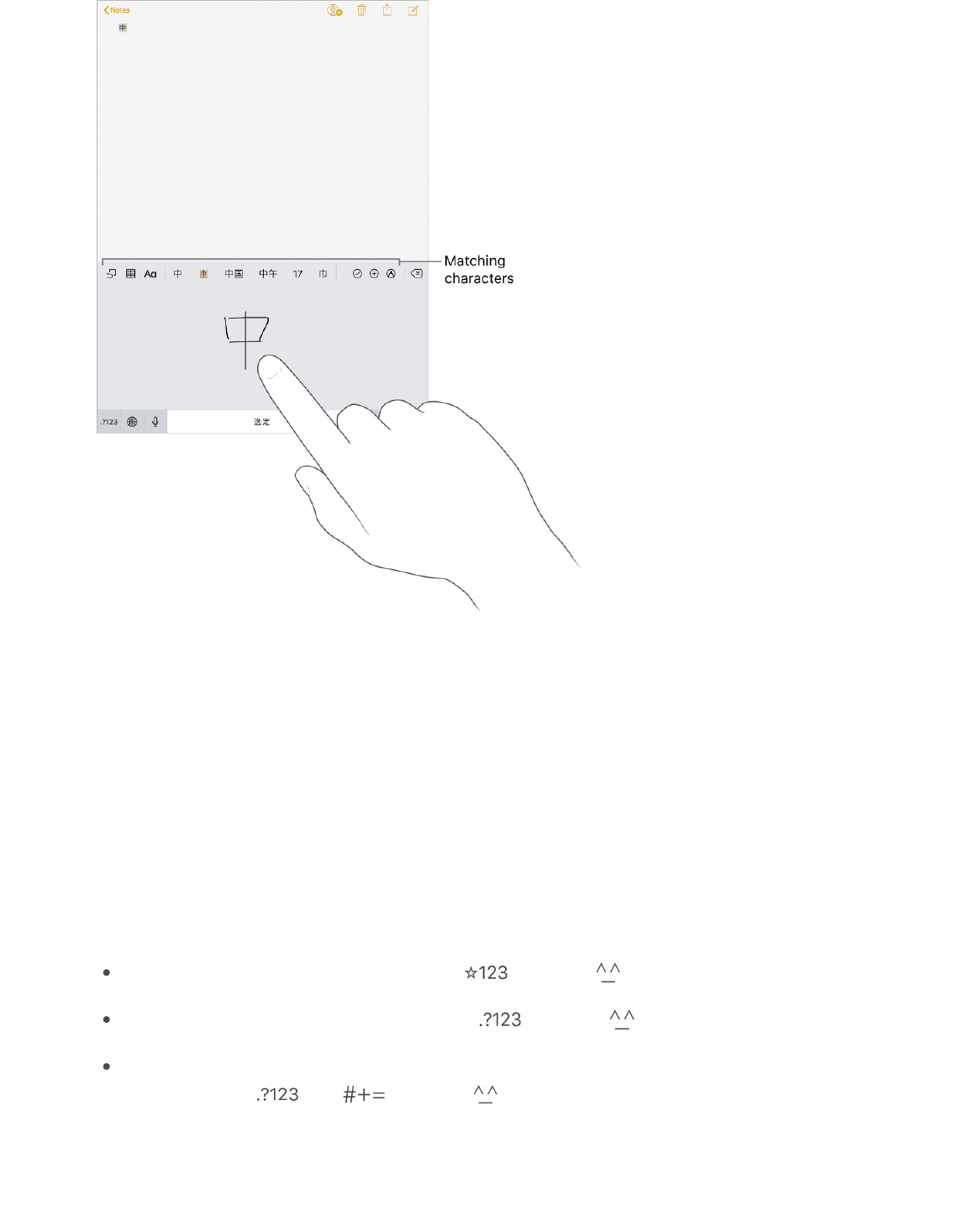
You can type some complex characters, such as (part of the name for the Hong Kong
International Airport), by writing two or more component characters in sequence. Tap the
character to replace the characters you typed. Roman characters are also recognized.
Type Japanese kana. Use the Kana keypad to select syllables. For more syllable options,
tap the arrow key and select another syllable or word from the window.
Type Japanese romaji. Use the Romaji keyboard to type syllables. Alternative choices
appear along the top of the keyboard; tap one to type it. For more syllable options, drag
the list to the left or tap the arrow key.
Type facemarks or emoticons. Do one of the following:
Use the Japanese Kana keyboard: Tap , then tap .
Use the Japanese Romaji keyboard: Tap , then tap .
Use the Chinese (Simplified) Pinyin or Chinese (Traditional) Zhuyin or Pinyin
keyboard: Tap , tap , then tap .

Messages
Send and receive messages
Use Messages to send and receive texts, photos, videos, and more through iMessage or
SMS/MMS services. With the iMessage service, you can enhance your messages with
bubble effects, invisible ink, full-screen effects, your own handwriting, Digital Touch,
iMessage apps, stickers, and more.
Start a conversation. Tap . Enter the recipientʼs phone number or email address, or
tap , then choose a contact. Tap the text field, then enter your message. Tap to
send.
Alternatively, to start a conversation from Mail, Calendar, or Notes, touch and hold a
phone number, then tap Send Message.
Send a message to a group. Tap , then enter multiple recipients.
Tip: To see what time a message was sent or received, drag a bubble to the left.
An alert appears if a message canʼt be sent. Tap the alert to try sending the message
again.
Manage a group conversation. Tap . You can name the conversation, add someone to
the conversation, or leave the conversation.
Apps

Use Business Chat in Messages. (not available in all regions; beta) In Messages, you
can communicate with businesses that offer Business Chat. You can get answers to
questions, resolve issues, get advice on what to buy, make purchases with Apple Pay,
and more. Use Siri, Safari, Search, or Maps on iPad to find a business you want to start a
conversation with. Then tap a text link or a button—for example, , , or the company
logo—to start a conversation (the appearance of the link varies with the context). You
can also initiate a chat with some businesses from their website or iOS app.
Resume a conversation. Tap the conversation in the Messages list.
Ask Siri. Say something like:
“Send a message to Eliza saying how about tomorrow”
“Reply thatʼs great news”
“Read my messages”
“Read my last message from Bob”
Use emoji. When typing a message, tap or to switch to the Emoji keyboard. To
automatically replace text with emoji, tap the highlighted words.
Hide the keyboard. Tap in the lower-right corner.
Respond with a Tapback. To send a quick response that lets people know what youʼre
thinking, double-tap a message, then choose your response.
View and manage conversation details. Tap . You can:
Tap a contact to view the contact card.
Perform quick actions such as making a call.
Send your current location or share your location for a specified length of time.
Hide alerts.
Send read receipts.
View images and attachments.

Search conversations. Scroll to the top of the Messages list to reveal the search field,
then enter the text youʼre looking for. You can also search conversations from the Home
screen. See .
Delete a conversation. In the Messages list, swipe left on the conversation, then tap
Delete.
Note: You canʼt recover a deleted conversation.
Set up iMessage and SMS/MMS
With the Messages app, you can exchange messages with other SMS and MMS devices
using your cellular connection, and with other iOS devices and Mac computers using
iMessage.
iMessage is an Apple service that sends messages over Wi-Fi or cellular connections to
other iOS devices (with iOS 5 or later) and Mac computers (with OS X 10.8 or later).
These messages donʼt count against your messaging plan. Messages sent via iMessage
can include photos, videos, and other info. You can see when other people are typing,
and send read receipts to let them know when youʼve read their messages. For security,
messages sent via iMessage are encrypted before theyʼre sent.
iMessage texts appear in blue bubbles, and SMS/MMS texts appear in green bubbles. For
more information about SMS/MMS and iMessage, see the Apple Support article
.
Sign in to iMessage. Go to Settings > Messages, then turn on iMessage.
If youʼre signed in to iMessage with the same Apple ID on all your devices, all the
messages that you send and receive on iPad can also appear on your other Apple
devices. Send a message from whichever device is closest to you, or to start
a conversation on one device and continue it on another.
Sign in to iMessage on your Mac and other Apple devices using the same Apple ID.
iOS devices: Go to Settings > Messages, then turn on iMessage.
Mac: Open Messages. If youʼre signing in for the first time, enter your Apple ID and
password, then click Sign In. If you signed in before and want to use a different
Apple ID, choose Messages > Preferences, click Accounts, then select iMessage in
the Accounts list.
With Continuity, all the SMS/MMS messages that you send and receive on your iPhone
can also appear on iPad. For more information, see the Apple Support article
.
Search
Use
Messages with your iPhone, iPad, or iPod touch
use Handoff
Use
Continuity to connect your iPhone, iPad, iPod touch, and Mac

Use Messages in iCloud. Go to Settings > [your name] > iCloud, then turn on Messages
(if itʼs not already turned on).
Using Messages in iCloud frees up space on your iPad by storing your messages in
iCloud, along with the accompanying photos and other attachments. With Messages in
iCloud turned on, all the messages you send and receive on iPad appear on your other
Apple devices where youʼre signed in to iMessage with the same Apple ID. Messages you
delete from iPad are removed from your other Apple devices.
Share photos, videos, and audio
With iMessage or MMS, you can send messages with photos, videos, and audio. Your
carrier determines the size limit of attachments; iPad may compress photo and video
attachments when necessary.
Send a photo or video. Tap . You can:
Take a photo within Messages: Frame the shot in the viewfinder, then tap .
Choose a recent photo or video: Swipe left to browse through recent shots.
Take a photo or video using Camera: Tap Camera.
Choose a photo or video from your Photo Library: Tap Photos.
Then, tap to send or to cancel.
Mark up a photo. Tap the photo in the message bubble, then tap Markup. Draw on the
photo with the Markup tools. See .
Find and share trending photos and videos from the web. See .
Use Markup
iMessage apps

Send an audio message. Touch and hold to record an audio message, then lift your
finger to stop recording. Tap to listen to your message before you send it. Tap to
send or to cancel.
Note: To save space, iPad automatically deletes audio messages two minutes after you
listen to them, unless you tap Keep. To always keep them, go to Settings > Messages >
Expire (below Audio Messages), then tap Never.
Forward a message or attachment. Touch and hold a message or attachment, tap
More, select additional items if desired, then tap .
Share, save, or print an attachment. Tap the attachment, then tap .
Copy an attachment. Touch and hold the attachment, then tap Copy.
Share items from another app. In the other app, tap Share or , then tap Message.
Delete a message or attachment. Touch and hold a message or attachment, tap More,
select additional items if desired, then tap .
iMessage apps
With iMessage apps, you can decorate a conversation with stickers, schedule dinner and
a movie, share a song, and more—all without leaving Messages. Expand your options by
downloading more iMessage apps from the App Store.
Browse and download iMessage apps. Tap , then tap .
Use an iMessage app. Tap an app to open it, then tap an item to add it to the message
bubble. Add a comment if you want, then tap to send or to cancel.
Decorate with stickers. Tap a stickers app to open it, touch and hold a sticker, then drag
it anywhere in the conversation. Before you release, you can:

Adjust the angle: Rotate a second finger around the finger dragging the sticker.
Adjust the size: Move a second finger closer to or away from the finger dragging the
sticker.
You can place the sticker on top of a message bubble, put it on another sticker, or even
dress up a photo.
See text covered by a sticker. Double-tap the sticker.
See sticker details. Touch and hold a sticker, then tap Sticker Details. You can:
See who sent the sticker.
View the iMessage app that sent the sticker.
Delete the sticker—swipe left, then tap Delete.
Manage iMessage apps. Tap , then tap Edit. You can:
Reorder apps: Drag .
Add an app to your Favorites: Tap .
Remove an app from your Favorites: Tap .
Hide an app: Turn the app off.
Delete an iMessage app. Tap , swipe left on the iMessage app, then tap Delete.
Pay friends with Apple Pay (U.S. only)
Use Apple Pay to send and receive money quickly and easily in Messages. Thereʼs no app
to download, and you can use the cards you already have with Apple Pay.
When you receive money in Messages, itʼs added to your Apple Pay Cash card. See
.
Send
and receive money (U.S. only)

Before you send or receive payments with Apple Pay, you need to agree to the terms and
conditions of this service.
Send a payment. In an iMessage conversation, tap , then tap . Enter the amount,
tap Pay, then add a comment if you want.
Tip: If thereʼs an underlined monetary amount in a message, tap it to preset the
payment.
To complete the payment, tap , then authenticate with Touch ID or enter your
passcode.
Request a payment. Tap , enter the amount, then tap Request.
Apple Pay Cash and sending and receiving payments through Apple Pay are services provided by Green Dot
Bank, member FDIC.
Digital Touch
With iMessage, you can use Digital Touch to send sketches, taps, kisses, heartbeats, and
more. You can even add a Digital Touch effect to a photo or video.
Sketch. Tap , tap , then draw with one finger. You can change the color, then start
drawing again. Tap to send.

Express your feelings. Tap , then use gestures on the canvas to send a Digital Touch
effect. Your feelings are sent automatically when you finish the gesture:
Tap: Tap with one finger to create a burst of color. You can change the color, then tap
again.
Fireball: Touch and hold with one finger.
Kiss: Tap with two fingers.
Heartbeat: Touch and hold with two fingers.
Heartbreak: Touch and hold with two fingers until you see a heartbeat, then drag
down to break the heart.
Add a Digital Touch effect to a photo or video. Tap , then tap . Tap to take a
photo or to record a video. Add a Digital Touch effect, such as a sketch or kiss, then
tap to send.
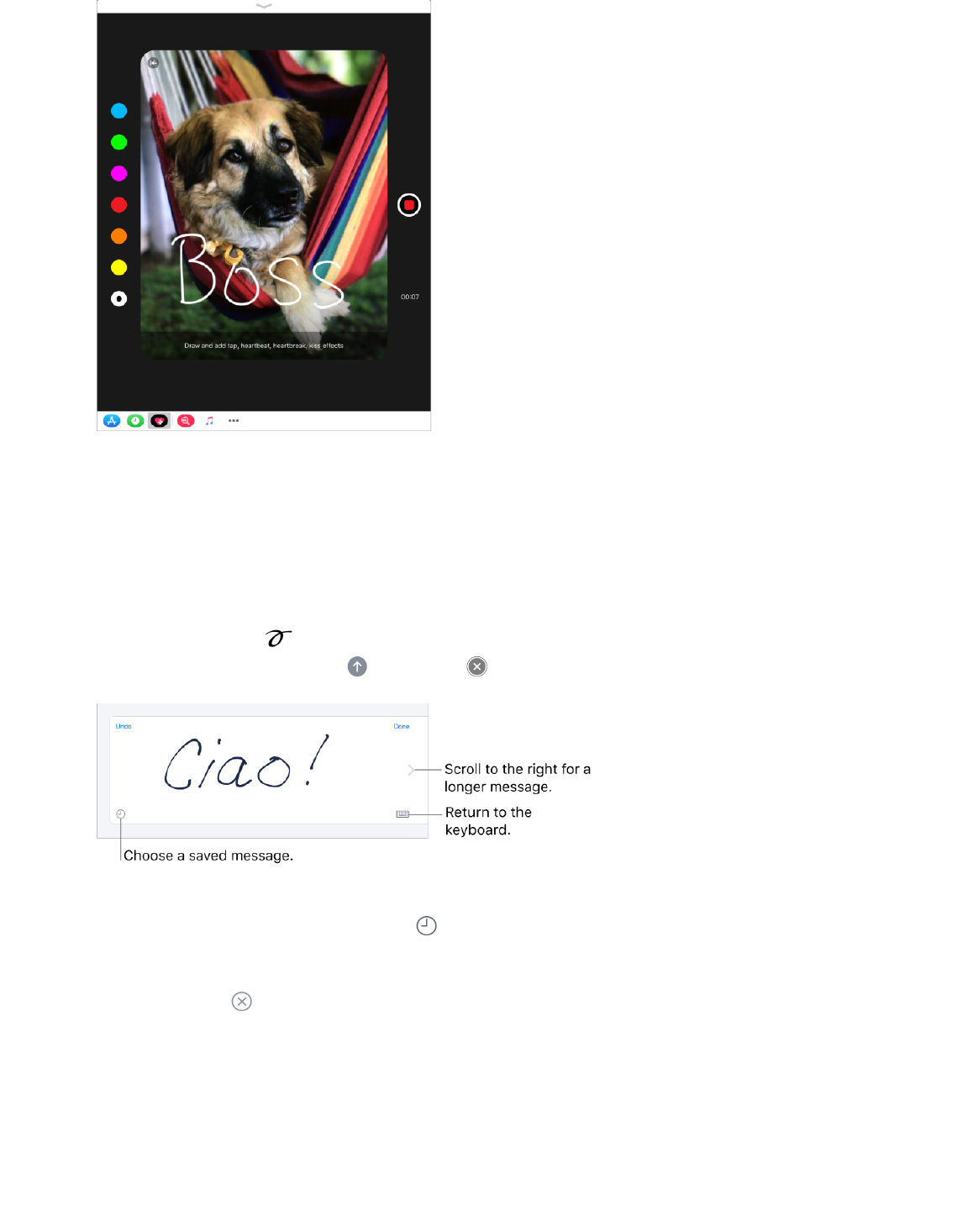
Handwritten messages
With iMessage, you can send a handwritten message. The recipient sees the message
animate, just as ink flows on paper.
Create and send a handwritten message. Tap the text field to see the onscreen
keyboard, then tap . Write a message with your finger or Apple Pencil (on supported
models). Tap Done, then tap to send or to cancel.
Send a saved message. After you create and send a handwritten message, the message
is saved so you can use it again. Tap , then choose a saved message.
Remove a saved message. Touch and hold a handwritten message until the messages
jiggle, then tap in the top-left corner. Tap any saved message when youʼre done.
Animate messages
With iMessage, you can animate a single message with a bubble effect or fill the entire
message screen with a full-screen effect. You can even send a personal message with
invisible ink.
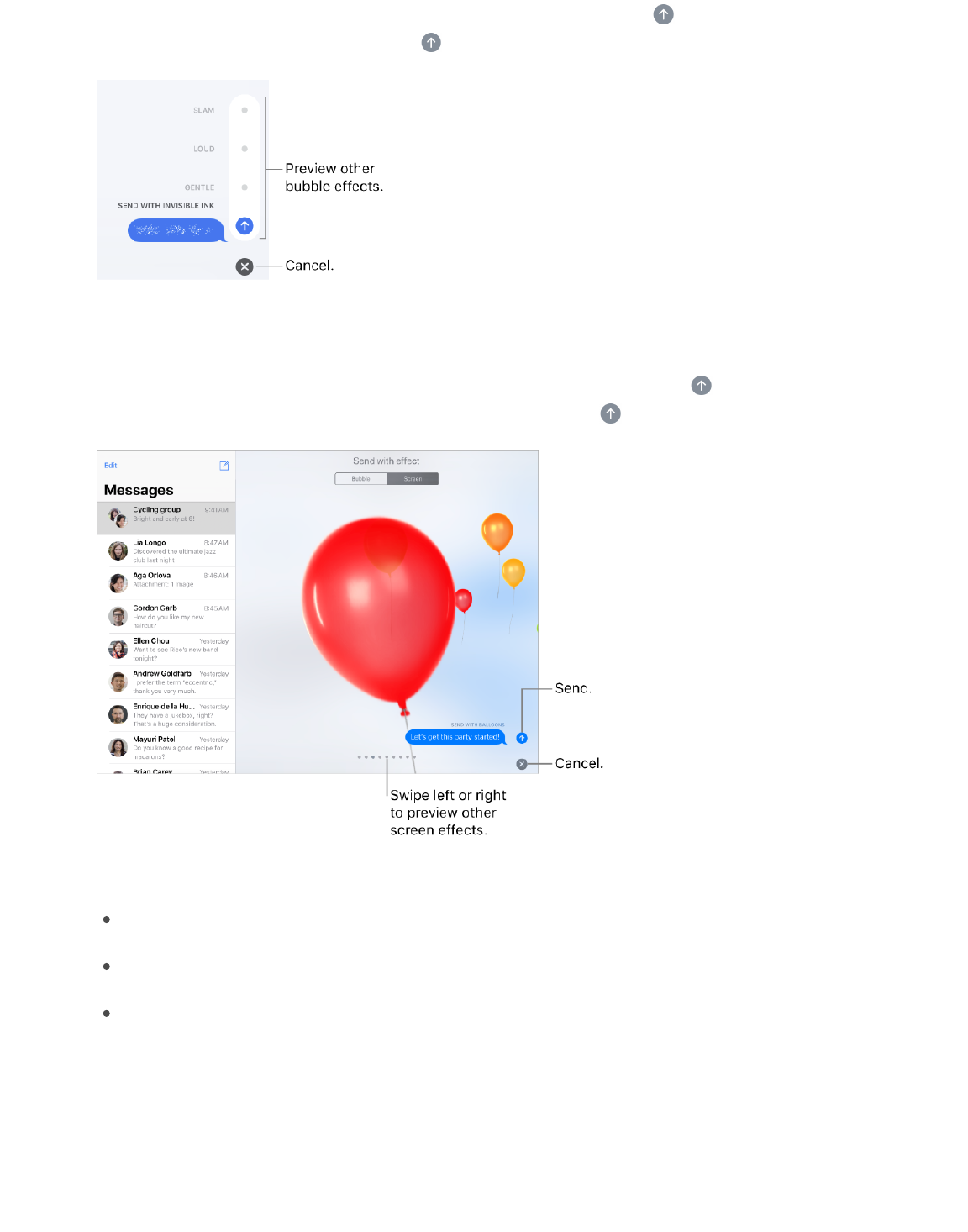
Use a bubble effect. After you type a message, touch and hold . Tap the choices to
preview different bubble effects. Tap to send.
Tip: Want to send a personal message? When you use invisible ink, the message
remains blurred until the recipient swipes to reveal it.
Use a full-screen effect. After you type a message, touch and hold , then tap Screen.
Swipe left or right to preview different screen effects. Tap to send.
iMessage automatically uses the following screen effects for specific text strings:
Balloons for “Happy birthday”
Confetti for “Congratulations”
Fireworks for “Happy New Year”
Manage message notifications and privacy
Manage notifications for messages. Go to Settings > Notifications > Messages. See
.
Notifications

Set the alert sound for messages. Go to Settings > Sounds > Text Tone. See
.
Assign a different ringtone to a contact. Go to Contacts, select a contact, tap Edit,
then tap Text Tone. To allow alerts for messages sent by this contact even when Do Not
Disturb is on, turn on Emergency Bypass.
Mute notifications for a conversation. In the Messages list, swipe left on the
conversation, then tap Hide Alerts.
Block unwanted messages and calls. View the conversation, tap , tap the phone
number or name to view the contact card, then scroll down and tap Block this Caller. To
view and manage your list of blocked phone numbers and contacts, go to Settings >
Messages > Blocked. For more information, see the Apple Support article
.
Filter iMessage messages from unknown senders. Go to Settings > Messages, then
turn on Filter Unknown Senders. This turns off iMessage notifications from senders who
arenʼt in your contacts and moves the messages to the Unknown Senders tab in the
Messages list.
You canʼt open any links in a message from an unknown sender until you add the sender
to your contacts or reply to the message. If the message is spam, tap Report Junk (below
the message) to delete and send the message to Apple.
Sounds
and silence
Block phone
numbers and contacts or filter messages on your iPhone, iPad or iPod touch
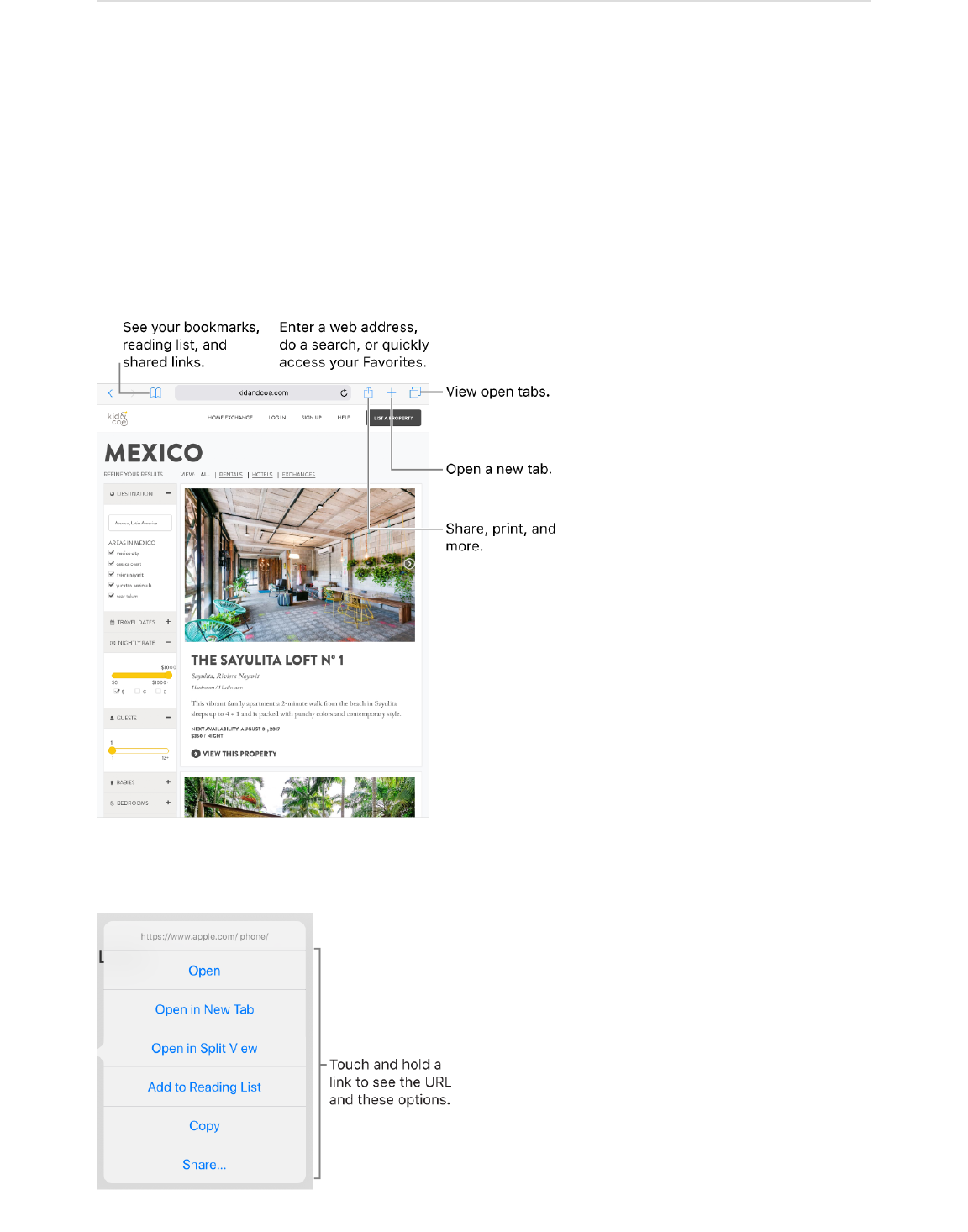
Safari
Browse the web
With Safari on iPad, you can browse the web, add webpages to your reading list to read
later, and add page icons to the Home screen for quick access. If you sign in to iCloud
with the same Apple ID on all your devices, you can see pages you have open on other
devices, and keep your bookmarks, history, and reading list up to date on all your
devices.
Look before you leap. To see the URL of a link before you go there, touch and hold the
link.

Open a link in a new tab. Touch and hold the link, then tap Open in New Tab. Or, tap the
link with two fingers. To automatically switch to the new tab whenever you open a link in a
new tab, go to Settings > Safari, then turn off Open New Tabs In Background.
View two pages side-by-side. Turn iPad to landscape orientation. You can:
Open a link in Split View: Touch and hold the link, then tap Open in Split View.
Open a blank page in Split View: Touch and hold , then tap Open Split View.
Move a tab to the other side of Split View: Drag the tab left or right from the tab bar.
Merge or close all tabs: Touch and hold .
Browse open tabs. Tap , or pinch closed with three fingers to view all your open tabs.
If you have several open tabs, tabs for the same site are stacked.
Close a tab: Tap in the upper-left corner, or swipe left on the tab.
Return to viewing a single tab: Tap a tab, tap Done, or pinch open with three fingers.
View tabs that are open on your other devices. If you sign in to iCloud with the same
Apple ID on all your devices, and you turn on Safari in Settings > [your name] > iCloud on
iPad, you can view tabs that are open on your other devices. Tap , then scroll to the list
at the bottom. To close a tab, swipe left, then tap Close.
Reopen a recently closed tab. Touch and hold , then choose from the list of recently
closed tabs.
Get back to the top. Double-tap the top edge of the screen to quickly return to the top
of a long page.
See more of the page. Turn iPad to landscape orientation.
Refresh the page. Tap next to the address in the search field.
See a tabʼs history. Touch and hold or .
Share links. Tap .
View the desktop version of a site. To see the full desktop version of a site instead of
the mobile version, tap , then tap Request Desktop Site.
Show or hide the tab bar. Go to Settings > Safari, then turn Show Tab Bar on or off.
Block pop-ups. Go to Settings > Safari, then turn on Block Pop-ups.
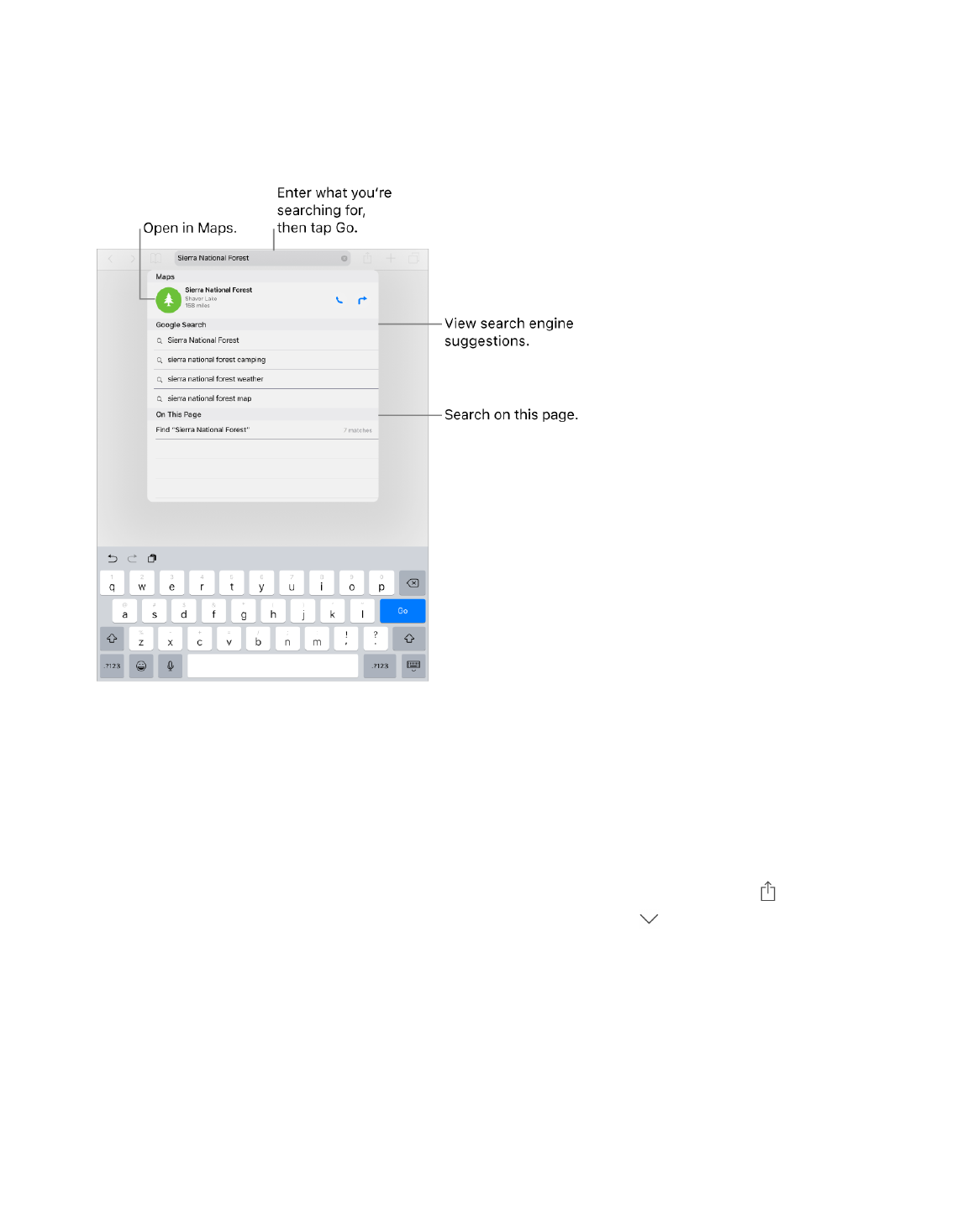
Search the web
Search the web. Enter a URL or search term in the search field at the top of the page,
then tap a search suggestion, or tap Go on the keyboard to search for exactly what you
typed. If you donʼt want to see suggested search terms, go to Settings > Safari, then turn
off Search Engine Suggestions (below Search).
Quickly search a site youʼve visited before. Enter the name of the site, followed by
your search term. For example, enter “wiki einstein” to search Wikipedia for “einstein.” Go
to Settings > Safari > Quick Website Search to turn this feature on or off.
See your favorites when you enter an address, search, or create a new tab. Go to
Settings > Safari > Favorites, then select the folder with the favorites you want to see.
Search the page. To find a specific word or phrase on the current page, tap , then tap
Find on Page. Enter the word or phrase in the search field. Tap to find other instances.
Choose your search engine. Go to Settings > Safari > Search Engine.

Add bookmarks and favorites
Bookmark the current page. Touch and hold , then tap Add Bookmark.
View and organize your bookmarks. Tap , then tap the Bookmarks tab. To create a
new folder or delete, rename, or reorder bookmarks, tap Edit.
Add a webpage to your favorites. Open the page, tap , then tap Add to Favorites.
Quickly see your favorite and frequently visited sites. Tap the search field to see your
favorites. Scroll down to see frequently visited sites. (To avoid seeing a list of these sites,
go to Settings > Safari, then turn off Frequently Visited Sites.)
Edit your favorites. Tap , tap the Bookmarks tab, tap Favorites, then tap Edit to
delete, rename, or rearrange your favorites.
See your Mac bookmarks on iPad. Go to Settings > [your name] > iCloud, then turn on
Safari.
Add an icon for the current page to your Home screen. To quickly access the page
from your Home screen, tap , then tap Add to Home Screen. The icon appears only on
the device where you add it.
Save a reading list for later
Save interesting items in your reading list so you can revisit them later. You can even save
the items in your reading list to iCloud and read them later when youʼre not connected to
the Internet.

Add the current page to your reading list. Tap , then tap Add to Reading List.
Add a linked page without opening it. Touch and hold the link, then tap Add to Reading
List.
View your reading list. Tap , then tap .
Delete an item from your reading list. In your reading list, swipe the item to the left.
Automatically save all reading list items to iCloud for offline reading. Go to Settings >
Safari, then turn on Automatically Save Offline (below Reading List).
Fill in forms
When you sign in to a website, sign up for a service, or make a purchase, you can fill in a
web form using the onscreen keyboard, or have Safari fill it in for you using AutoFill.
Turn on AutoFill. Go to Settings > Safari > AutoFill.

Save and use passwords with AutoFill.
Save your password: Enter your password. When youʼre asked if you want to save the
password for the site, tap Yes.
Let Safari suggest a password for a new account: Tap the password field, tap Suggest
Password, then tap Use Suggested Password.
Use a saved password: Safari automatically fills in your user name and password if
youʼve previously saved them for a site. If you use multiple identities with a site and
an incorrect identity is filled in, tap Passwords above the keyboard, then select the
identity you prefer.
View your saved passwords. Go to Settings > Accounts & Passwords > App & Website
Passwords, then use Touch ID or enter your passcode.
Fill in a form. Tap a field to bring up the keyboard. Tap or above the keyboard to
move from field to field.
Fill it in automatically. When you fill in contact information on a website that supports
AutoFill, tap AutoFill Contact above the keyboard. Tap Customize to edit and store your
information for next time. Or, tap Other Contact to fill in someone elseʼs information.
Add a credit card for purchases. Go to Settings > Safari > AutoFill > Saved Credit
Cards > Add Credit Card. To enter the information without typing, tap Use Camera, then
position iPad so that your card appears in the frame. Also, when you make an online
purchase, you can allow Safari to save the credit card information. See .
Use your credit card information. When you fill in credit card information, tap AutoFill
Credit Card above the keyboard. Enter your cardʼs security code, which isnʼt stored. For
greater security of your credit card information, for iPad.
Submit a form. Tap Go, Search, or the link on the webpage.
Use Reader for distraction-free reading
Use Safari Reader to view a page without ads, navigation, or other distracting items.
iCloud Keychain
use a passcode

Focus on content. Tap at the left end of the address field. If you donʼt see the icon,
Reader isnʼt available for the page youʼre looking at.
Share just the good stuff. To share just the article text and a link to it, tap while
viewing the page in Reader.
Return to the full page. Tap in the address field again.
Use Reader automatically. On a supported website, touch and hold , then choose to
use Reader automatically on the current website or on all websites.
Privacy and security
Adjust Safari settings to keep your browsing activities private and protect yourself from
malicious websites.
Control privacy and security settings for Safari. Go to Settings > Safari. Below Privacy
& Security, you can:
Prevent cross-site tracking: Safari limits third-party cookies and data by default. Turn
it off to allow cross-site tracking.
Block all cookies: To remove cookies already on iPad, go to Settings > Safari > Clear
History and Website Data.
Ask websites not to track you: But beware—a website can choose not to honor the
request.
Get warnings about fraudulent websites: Safari displays a warning if youʼre visiting a
suspected phishing website.
Tip: Safari displays a warning in the search field when you visit a website that is
insecure.
Erase your browsing history and data from iPad. Go to Settings > Safari > Clear
History and Website Data.
Visit sites without making history. Tap , then tap Private. While Private Browsing
Mode is on, the Safari background is black instead of white, and sites you visit donʼt
appear in History on iPad or in the list of tabs on your other devices. To hide the sites and
exit Private Browsing Mode, tap , then tap Private again. The sites reappear the next
time you use Private Browsing Mode.
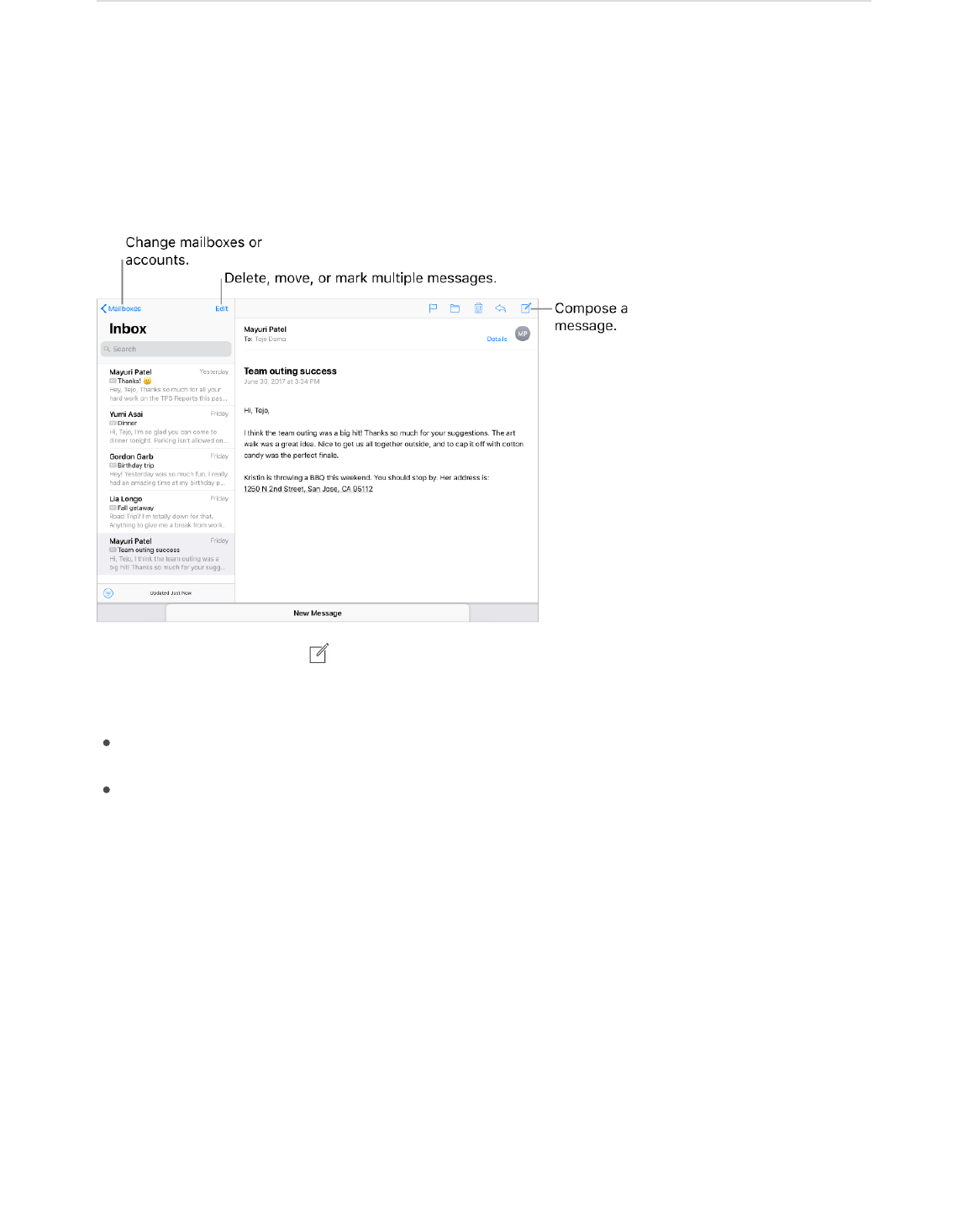
Mail
Write messages
WARNING: For important information about avoiding distractions that could lead to
dangerous situations, see .
Create a message. Tap . Touch and hold to view draft messages youʼve saved.
Ask Siri. Say something like:
“New email to John Bishop”
“Email Simon and say I got the forms, thanks”
Draw in your message. Double-tap in the message body, tap Insert Drawing, then use
the drawing and annotation tools. Tap Done to insert the drawing into your message. See
.
Important safety information
Use Markup
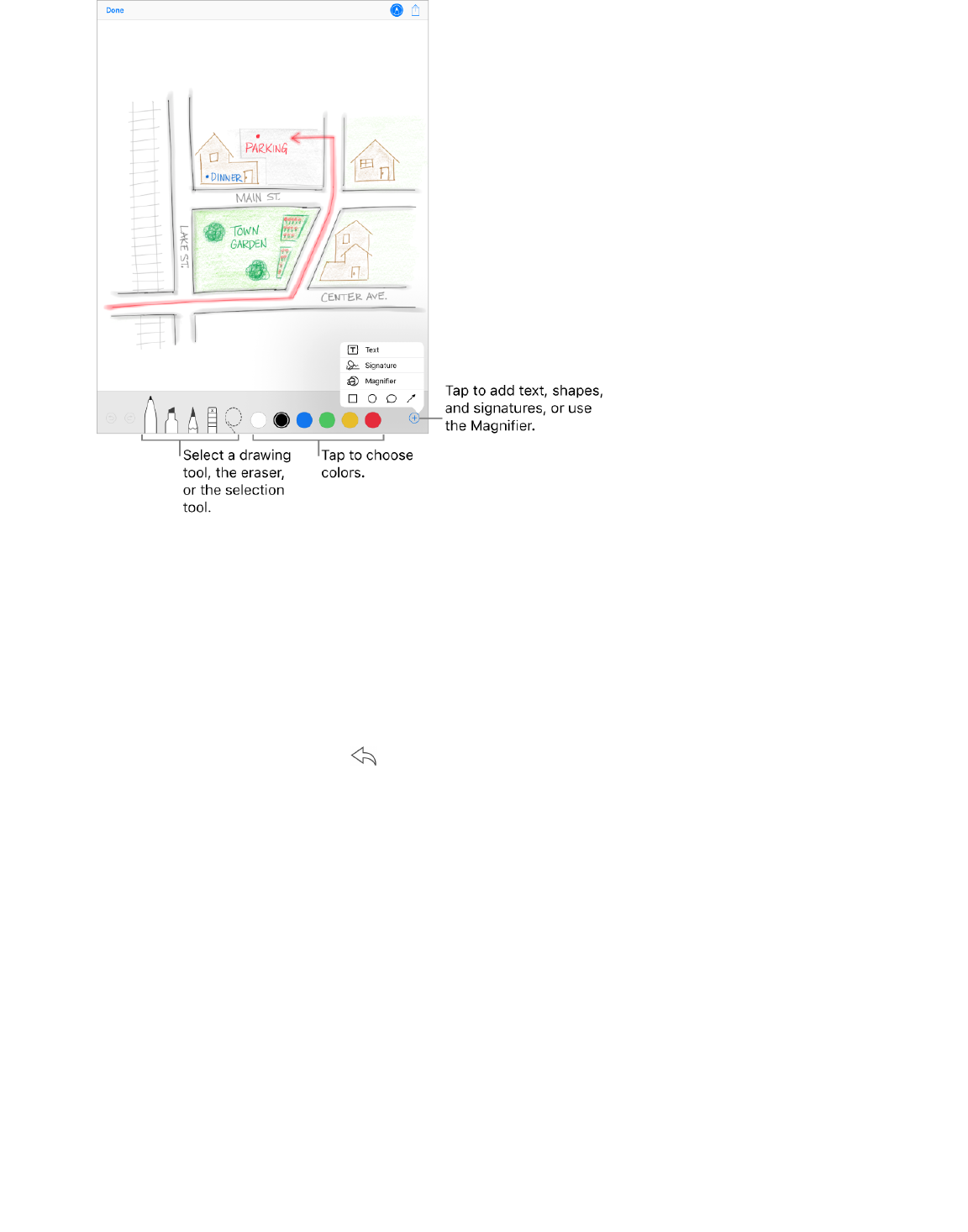
Add attachments. Double-tap in the message body, tap Add Attachment, then select a
document in . You can also drag and drop to attach a file to your message. See
.
Insert a photo or video. Double-tap in the message body, then tap Insert Photo or
Video. You can also drag and drop to insert a photo or video. See .
Quote some text when you reply. Touch and hold in the message body, then select the
text you want to include. Tap , then tap Reply. To turn off the indentation of the quoted
text, go to Settings > Mail > Increase Quote Level.
Send a message from a different account. Tap the From field to choose an account.
Change a recipient from Cc to Bcc. After you enter recipients, you can drag them from
one field to another or change their order.
Mark addresses outside certain domains. When youʼre addressing a message to a
recipient whoʼs not in your organizationʼs domain, you can have the recipientʼs name
colored in red to alert you. Go to Settings > Mail > Mark Addresses, then define the
domains that you donʼt want marked. You can enter multiple domains separated by
commas, such as “apple.com, example.org.”
Add additional mail accounts. Go to Settings > Accounts & Passwords > Add Account >
Other > Add Mail Account.
Change your mail signature. Go to Settings > Mail > Signature. If you have more than
one mail account, tap Per Account to set a different signature for each of them.
Files Drag
and drop items
Drag and drop items
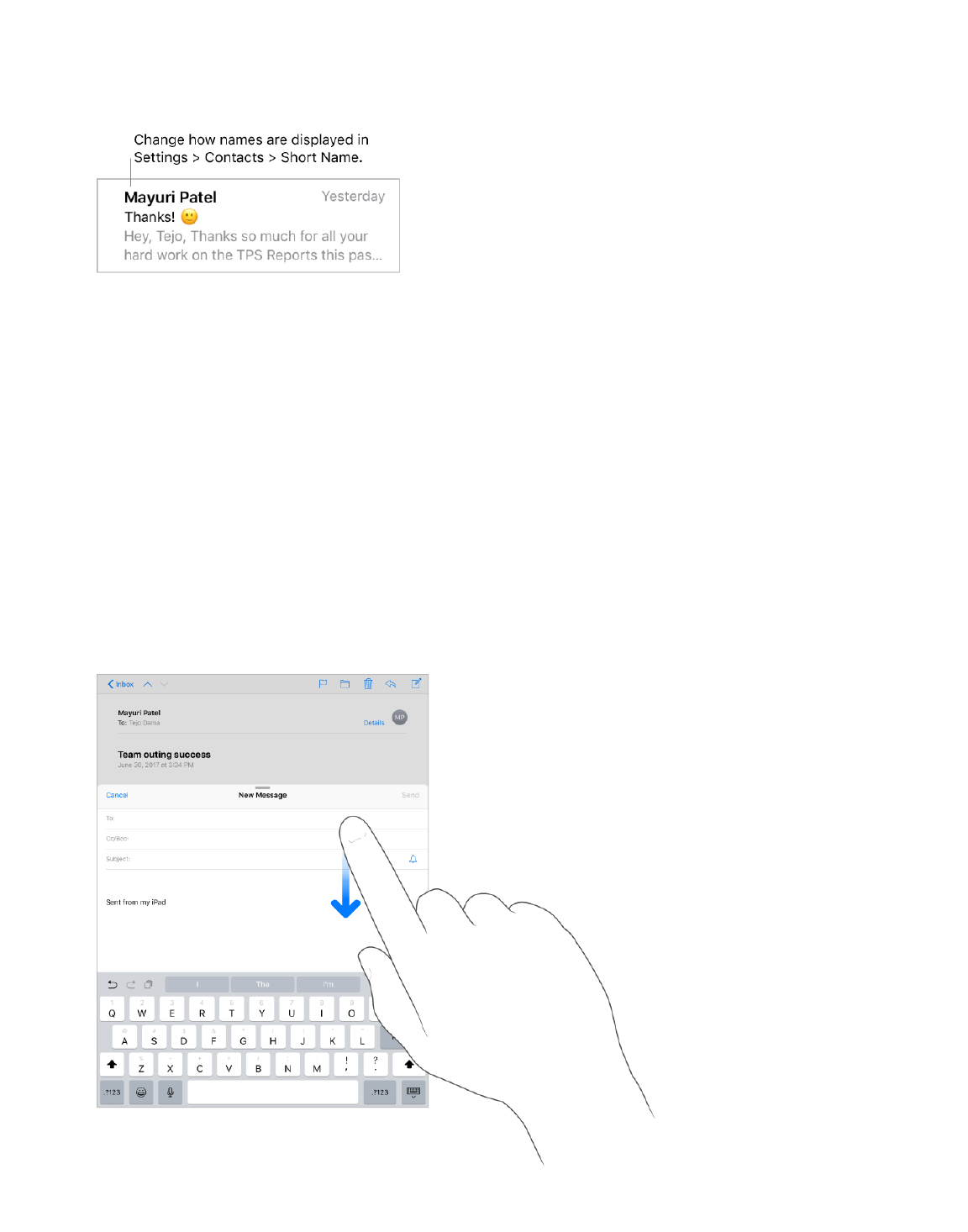
Automatically send a copy to yourself. Turn on Settings > Mail > Always Bcc Myself.
Preview your messages
See a longer preview. Go to Settings > Mail > Preview. You can show up to five lines.
Is this message for me? Go to Settings > Mail, then turn on Show To/Cc Labels. In the
message list, a label next to your name indicates how it was addressed to you. You can
also use the To/Cc mailbox, which gathers all mail addressed to you. To show or hide it,
tap Mailboxes, then tap Edit.
Finish a message later
Look at another message while youʼre writing one. Swipe down on the title bar of a
message youʼre writing. When youʼre ready to return to your message, tap its title at the
bottom of the screen. If you have more than one message waiting to be finished, tap the
bottom of the screen to see them all.

Save a draft for later. If youʼre writing a message and want to finish it later, tap Cancel,
then tap Save Draft. To get it back, touch and hold .
With OS X 10.10 or later, you can also hand off unfinished messages with your Mac. See
.
See important messages
Get notified of replies to a message or thread. Tap , then tap Notify Me. While youʼre
writing a message, you can also tap in the Subject field. To change how notifications
appear, go to Settings > Notifications > Mail > Thread Notifications.
Gather important messages. Add important people to your VIP list, so all their
messages appear in the VIP mailbox. When viewing a message, tap Details, tap the
senderʼs name to display their contact info, then tap Add to VIP. To change how
notifications appear, go to Settings > Notifications > Mail > VIP.
Get notified of important messages. Notifications can let you know when you receive
messages in favorite mailboxes or messages from your VIPs. Go to Settings >
Notifications > Mail.
Ask Siri. Say something like: “Any new mail from Nanditha today?”
Flag a message so you can find it later. Tap while reading the message. To change
the appearance of the flagged message indicator, go to Settings > Mail > Flag Style. To
see the Flagged smart mailbox, tap Edit while viewing the Mailboxes list, then tap
Flagged.
Search for a message. Scroll to the top of the message list to reveal the search field,
then type the text youʼre looking for. Choose between searching all mailboxes or the
current mailbox above the results list. Tap a message in the results list to see it, then tap
the up and down arrows to scroll through the other messages. Searching looks at the
address fields, the subject, and the message body. The most relevant messages appear
in Top Hits above the search suggestions as you type.
Search by timeframe. Scroll to or tap the top of the message list to reveal the search
field, then type something like “February meeting” to find all messages from February
with the word “meeting.”
Search by message state. To find all flagged, unread messages from people in your VIP
list, type “flag unread vip.” You can also search for other message attributes, such as
“attachment.”
Junk be gone! Tap while youʼre reading a message, then tap Move to Junk to file it in
the Junk folder. If you accidentally move a message, shake iPad immediately to undo.
Handoff

Make a favorite mailbox. Favorite mailboxes appear at the top of the Mailboxes list so
you can access them easily. To designate a favorite, tap Edit while viewing the Mailboxes
list. Tap Add Mailbox, then select the mailbox to add.
Show draft messages from all of your accounts. While viewing the Mailboxes list, tap
Edit, tap Add Mailbox, then turn on the All Drafts mailbox.
Delete messages
View then delete a message. Tap a message to open it. When youʼre ready to delete it,
tap . To turn the confirmation of deletion on or off, go to Settings > Mail > Ask Before
Deleting.
Delete a message with a swipe. While viewing a list of messages, swipe a message to
the left to reveal a menu of actions, then tap Trash. Or, to delete a message in a single
gesture, swipe it all the way to the left.
Delete multiple messages at once. While viewing a list of messages, tap Edit, select
some messages, then tap Trash. If you change your mind, shake iPad immediately to
undo.
Recover a deleted message. Go to the accountʼs Trash mailbox, open the message,
then tap and move the message. Or, if you just deleted it, shake iPad to undo. To see
deleted messages across all your accounts, add the All Trash mailbox. To add it, tap Edit
in the mailboxes list, then select it in the list.
Archive instead of delete. Instead of deleting messages, you can archive them so
theyʼre still around in the Archive mailbox if you need them. How you turn this option on
varies by the type of mail account you have configured. Go to Settings >
Accounts & Passwords. Tap your email account, tap Mail (below Advanced), then tap
Advanced. In the Advanced settings, change the destination mailbox for discarded
messages to Archive Mailbox. After youʼve turned this option on, to delete a message
instead of archiving it, touch and hold , then tap Trash Message.
Stash your trash. You can set how long deleted messages stay in the Trash mailbox. Go
to Settings > Accounts & Passwords. Tap your email account, tap Mail (below Advanced),
then tap Advanced. In the Advanced settings, tap Remove, then select a time interval.
Some email services might override your selection; for example, iCloud doesnʼt keep
deleted messages longer than 30 days, even if you select Never.
Attachments
Preview an attachment. Touch and hold an attachment, then tap Quick Look.